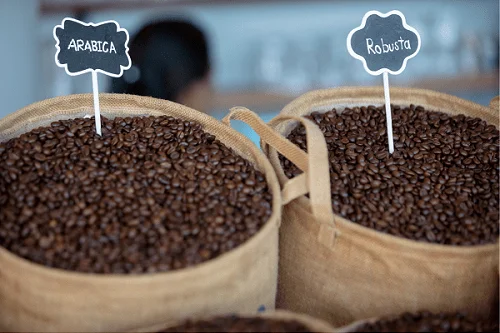Coffee
Arabica vs. Robusta: Understanding the Differences in Coffee Bean Varieties
Understanding the Differences between Arabica and Robusta
Arabica vs. Robusta Differences in Coffee beans. The world of coffee is different, with a wide range of flavors, aromas, and brewing styles. One of the most abecedarian distinctions in the coffee assiduity is between Arabica and Robusta beans.
Arabica beans are known for their delicate flavor and aroma and are grown in cool, high-altitude regions. They have a lower caffeine content compared to Robusta beans. On the other hand, Robusta beans are known for their strong, bitter taste, and are grown in warmer, low-altitude regions. They have an advanced caffeine content compared to Arabica beans.
The purpose of this blog post is to give a comprehensive understanding of Arabica and Robusta coffee beans, including their differences, growing regions, flavor biographies, and uses. Whether you’re a coffee dilettante or simply looking to expand your coffee knowledge, this post will guide you through the world of Arabica and Robusta beans, helping you to make informed choices about the coffee you drink.
What are Arabica beans?
1. Arabica beans are considered the “gold standard” of coffee beans due to their delicate flavor and aroma. They’re grown in cool, high-altitude regions and have a lower caffeine content compared to Robusta beans. These eans are known for their complex and nuanced flavor biographies that can range from notes of chocolate, fruit, and nuts.
2. The flavor profile of Arabica beans can be described as delicate, nuanced, and complex. The beans are known for their notes of chocolate, fruit, and nuts. They’re also considered to be less bitter than Robusta beans, making them a favorite among specialty coffee shops and dilettantes.
3. Arabica beans are grown in a variety of regions around the world, including the Western Ghats and Eastern Himalayas in India, as well as in countries like Ethiopia, Colombia, and Honduras. These regions are known for their cool climates, a high mound, and rich soil, which give the perfect conditions for growing high-quality Arabica beans.
4. Due to their delicate flavor and aroma, Arabica beans are preferred by specialty coffee shops and dilettantes. They’re frequently used in high-end composites and single-origin coffees, as they give a unique and complex taste experience. These beans are also considered to be of more advanced quality than Robusta beans, making them more precious.
What are Robusta beans?
1. Robusta beans are known for their strong, bitter taste and advanced caffeine content compared to Arabica beans. They’re grown in warmer, low-altitude regions, which give the perfect conditions for these hardy and complaint-resistant shops. These beans are considered to be of lower quality than Arabica beans, but they have a strong and robust flavor profile that’s unique.
2. The flavor profile of Robusta beans can be described as strong, robust, and bitter. The beans are known for their notes of nuts and chocolate. They’re also considered to be more bitter than Arabica beans, making them less popular among specialty coffee shops and dilettantes.
3. Robusta beans are grown in a variety of regions around the world, including the Deccan Plateau in India, as well as in countries like Vietnam, Indonesia, and Brazil. These regions are known for their warm climates, low mounds, and rich soil, which give the perfect conditions for growing high-quality Robusta beans.
4. Due to their strong, bitter taste and high caffeine content, Robusta beans are preferred by marketable coffee directors. They’re frequently used in instant coffee and lower-end composites, as they give a strong and robust flavor. They’re also used to add a stronger caffeine kick to composites and are less precious than Arabica beans.
Growing regions of Arabica beans in India:
Western Ghats:
- The Western Ghats region of India is known for its cool and misty climate, making it ideal for growing Arabica beans.
- Arabica beans grown in the Western Ghats are known for their unique flavor profile, which includes notes of chocolate and fruit.
- Some of the popular kinds of Arabica beans grown in the Western Ghats include Chikmagalur, Bababudangiris, and Coorg.
- The Western Ghats region is also home to a number of coffee colonies and estates which are popular sightseer destinations.
Eastern Himalayas:
- The Eastern Himalayas region of India is also known for its cool climate and high altitude, making it suitable for growing Arabica beans.
- Arabica beans grown in the Eastern Himalayas are known for their complex and nuanced flavor profile, which includes notes of chocolate and fruit.
- Some of the popular kinds of Arabica beans grown in the Eastern Himalayas include Darjeeling and Dooars.
- The Eastern Himalayas region is also known for its tea auditoriums and scenic beauty, which attracts numerous excursionists.
Growing regions of Robusta beans in India:
Deccan Plateau:
- India is known for its different climates and terrain, making it suitable for growing both Arabica and Robusta beans.
- Robusta beans are generally grown in the warmer and low-altitude regions of India similar to the Deccan Plateau.
- The Deccan Plateau region, which covers several countries similar to Andhra Pradesh, Tamil Nadu, and Karnataka, is known for its ideal climate and soil conditions for growing Robusta beans.
- Robusta beans grown in this region are known for their strong and robust flavor profile, which includes notes of nuts and chocolate.
- They’re also known for their advanced caffeine content compared to Arabica beans.
- Robusta beans grown in India are substantially used for making instant coffee and lower-end composites.
- The region is also known for its rich artistic heritage and literal monuments.
Choosing between Arabica and Robusta:
1. When choosing between Arabica and Robusta beans, there are several factors to consider, including flavor preference, caffeine content, and price. Arabica beans are known for their delicate flavor and aroma, while Robusta beans are known for their strong, bitter taste. Arabica beans also have a lower caffeine content compared to Robusta beans. It’s also important to consider the price, as Arabica beans tend to be more precious.
2. In coffee assiduity, composites are frequently used to produce a balance of flavor and caffeine. composites generally combine Arabica and Robusta beans, which can give a unique and complex taste experience. Some popular composites include Mocha Java, which combines beans from Ethiopia and Yemen, and French rally, which combines beans from Central and South America.
3. In conclusion, each variety of coffee beans has its own unique characteristics. It’s worth trying both Arabica and Robusta beans to discover which one you prefer. Arabica beans are known for their delicate flavor and aroma, while Robusta beans are known for their strong, bitter taste. Whether you prefer a strong and robust flavor or a delicate and nuanced flavor, there’s a coffee bean variety that will suit your taste.
Conclusion:
Summary of the main points bandied in the blog post
- We’ve talked about the two main types of coffee beans, Arabica and Robusta, and the differences between them.
- We’ve also stressed the unique characteristics and flavor profile of Indian coffee beans and the regions in India where they’re grown.
- The Arabica beans are grown in cool, high-altitude regions and have a delicate flavor and aroma, whereas Robusta beans are grown in warmer, low-altitude regions and have a strong, bitter taste.
- We’ve also discussed the fashionability and use of each variety and the part of composites in the coffee assiduity.
- In conclusion, it’s worth noting that each variety has its own unique characteristics and it’s worth trying different types of Indian coffee beans to discover which one you prefer. Indian coffee beans are known for their unique flavor profile and aroma, and they’re worth exploring.

